

Gestion de projet. L03-ProjectManagement.pdf. Les différentes étapes de la création d'un jeu vidéo. Beaucoup de personnes pensent encore que, comme il y a 15-20 ans, on peut encore faire un jeu dans son coin, à 2-3 personnes et avec peu de moyens.
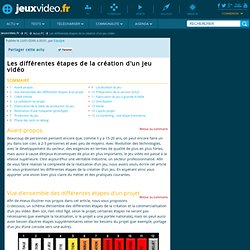
Avec l’évolution des technologies, avec le développement du secteur, des exigences en termes de qualité de plus en plus fortes, mais aussi à cause d’enjeux économiques de plus en plus importants, le jeu vidéo est passé à la vitesse supérieure. C’est aujourd’hui une véritable industrie, un secteur professionnalisé. Afin de vous faire réaliser la complexité de la réalisation d’un jeu, nous avons voulu écrire cet article en vous présentant les différentes étapes de la création d’un jeu. En espérant ainsi vous apporter une vision bien plus claire du métier et des pratiques courantes.Afin de mieux illustrer nos propos dans cet article, nous vous proposons ci-dessous, un schéma d’ensemble des différentes étapes de la création et la commercialisation d’un jeu vidéo.
Une fois le jeu finalisé, une phase très délicate et difficile va suivre. Documents/Referentiel_metiers/referentiel-detail_2012.pdf. Travailler dans le jeu vidéo : bien choisir son métier. Le temps où l’on concevait des jeux vidéo seul dans son garage est révolu.

Aujourd’hui, l’industrie du jeu vidéo regorge d’un immense panel de métiers, aussi bien dans la création, l’édition ou encore la distribution. La chaîne de valeur du jeu vidéo en France. L'industrie du jeu vidéo se définit en premier lieu par la création et la production de jeux vidéo sur différentes plateformes mais aussi par la production et la commercialisation de consoles (de salon ou mobile) permettant de " lire " ces jeux. Si l'industrie vidéoludique française est relativement développée sur le premier segment (création et production de jeux), elle l'est beaucoup moins sur le deuxième segment (production de consoles), qui est dominé par quelques acteurs mondiaux (Sony, Microsoft, Nintendo).
D'autres prestataires " techniques " et " spécialisés " actifs en France interviennent également, dans la fabrication d'accessoires ou dans la conception et " briques " de logiciels. 1. La chaîne de valeur du jeu vidéo en France La chaîne de valeur du jeu vidéo en France peut être analysée selon les catégories suivantes : Encadré 1 : Éléments de méthodologie sur l'analyse des entreprises du jeu vidéo en France Deux principaux retraitements ont par ailleurs été réalisés. Clarifying Aims and Purposes - Office of Quality Improvement. What are Agile Software Development approaches? Scrum, Kanban, XP explained. Several Agile frameworks are existing in the commercial market which are being widely used by the organizations.
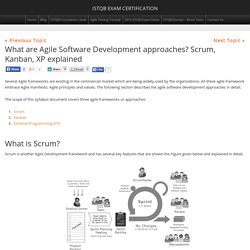
All these agile framework embrace Agile manifesto, Agile principles and values. The following section describes the agile software development approaches in detail. The scope of this syllabus document covers three agile frameworks or approaches: What is Scrum? 57 Terms You Need To Understand If You Make Games, All In One Place. Game Developers - 0615_gd_ACG_SP. 2011 IT Project Success Rates Survey Results. The Survey Results The survey results are summarized in my November 2011 Dr.

Dobb's Journal column How Successful are IT Projects, Really?. 4_fun_keys_chart.jpg (JPEG Image, 252 × 226 pixels) Approved_SitLead_Model.png (PNG Image, 292 × 434 pixels) Drive – Daniel H. Pink. * New York Times bestseller * Wall Street Journal bestseller * Boston Globe bestseller * Los Angeles Times bestseller * Washington Post bestseller * San Francisco Chronicle bestseller * Publishers Weekly bestseller * Indie Bound bestseller * Amazon.com top 50 bestseller for all of 2010 * Amazon.com top 100 bestseller for all of 2011.

Scaled Agile Framework. Lean manufacturing. Model of the "lean"-production process Overview[edit] The difference between these two approaches is not the goal itself, but rather the prime approach to achieving it.
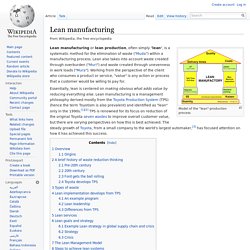
The implementation of smooth flow exposes quality problems that already existed, and thus waste reduction naturally happens as a consequence. The advantage claimed for this approach is that it naturally takes a system-wide perspective, whereas a waste focus sometimes wrongly assumes this perspective. Both lean and TPS can be seen as a loosely connected set of potentially competing principles whose goal is cost reduction by the elimination of waste.[6] These principles include: pull processing, perfect first-time quality, waste minimization, continuous improvement, flexibility, building and maintaining a long term relationship with suppliers, autonomation, load leveling and production flow and visual control.
Agile Teams « Scaled Agile Framework. Nothing beats an Agile Team.
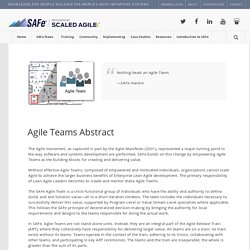
—SAFe mantra. Roles on Agile Teams: From Small to Large Teams. There are several key differences between the agile approach to team organization and the traditional approach.
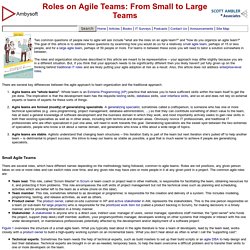
Agile teams are "whole teams". Whole team is an Extreme Programming (XP) practice that advises you to have sufficient skills within the team itself to get the job done. The implication is that the development team has the requisite testing skills, database skills, user interface skills, and so on and does not rely on external experts or teams of experts for these sorts of things. Agile teams are formed (mostly) of generalizing specialists. A generalizing specialist, sometimes called a craftsperson, is someone who has one or more technical specialties (e.g. Gantt chart. A Gantt chart showing three kinds of schedule dependencies (in red) and percent complete indications.
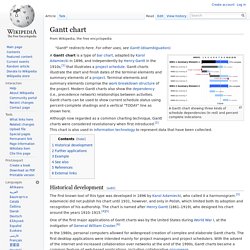
Although now regarded as a common charting technique, Gantt charts were considered revolutionary when first introduced.[2] This chart is also used in information technology to represent data that have been collected. Historical development[edit] The first known tool of this type was developed in 1896 by Karol Adamiecki, who called it a harmonogram.[3] Adamiecki did not publish his chart until 1931, however, and only in Polish, which limited both its adoption and recognition of his authorship. The chart is named after Henry Gantt (1861–1919), who designed his chart around the years 1910–1915.[4][5] PRINCE2. PRINCE2 (an acronym for PRojects IN a Controlled Environment, version 2) is a project management methodology.

The methodology encompasses the high level management, control and organisation of a project, but not lower level activities such as scheduling. PRINCE2 is also used to refer to the training and accreditation of authorised practitioners of the methodology who must undertake accredited qualifications to obtain certification. History[edit] Méthode agile. Certaines informations figurant dans cet article ou cette section devraient être mieux reliées aux sources mentionnées dans les sections « Bibliographie », « Sources » ou « Liens externes »(janvier 2013).
Améliorez sa vérifiabilité en les associant par des références à l'aide d'appels de notes. En ingénierie logicielle, les. Agile software development. Agile software development is a group of software development methods in which requirements and solutions evolve through collaboration between self-organizing, cross-functional teams. It promotes adaptive planning, evolutionary development, early delivery, continuous improvement, and encourages rapid and flexible response to change.[1] Software project management. Software project management is the art and science of planning and leading software projects.[1] It is a sub-discipline of project management in which software projects are planned, implemented, monitored and controlled.
History[edit] In the 1970s and 1980s, the software industry grew very quickly, as computer companies quickly recognized the relatively low cost of software production compared to hardware production and circuitry. Outline of project management. Project management – discipline of planning, organizing, securing, managing, leading, and controlling resources to achieve specific goals. A project is a temporary endeavor with a defined beginning and end (usually time-constrained, and often constrained by funding or deliverables), undertaken to meet unique goals and objectives,[1] typically to bring about beneficial change or added value. Waterfall or Agile? - Differences between predictive and adaptive software methodologies. Information Technologies (IT) continues to look for the "silver bullet" that will push software out as quickly... By submitting your personal information, you agree to receive emails regarding relevant products and special offers from TechTarget and its partners.
You also agree that your personal information may be transferred and processed in the United States, and that you have read and agree to the Terms of Use and the Privacy Policy. Adaptive Project Management. Will polar bears die because of global warming? Most likely not, as they, like any other living creatures, are capable of adapting.
Of course, if global warming turns out to be extreme, no adaptations the polar bears make will help them find suitable habitat.